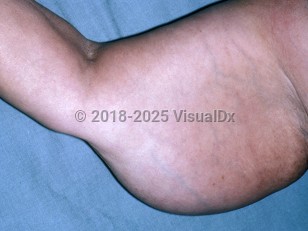The following classification has been proposed:
- Type I: Generalized diffuse form: widespread painful adipose tissue, no clear lipomas
- Type II: Generalized nodular form: pain in adipose tissue and within and around multiple lipomas
- Type III: Localized nodular form: pain within and around multiple lipomas
- Type IV: Juxta-articular form: solitary adipose deposit near a joint, eg the medial knee
In addition to being painful, it is also common for paresthesia of the overlying skin of the individual lipomas to be present. Degree of pain increases with body mass index (BMI). Other associated findings include hyperalgesia to light pressure, acral swelling, headache, telangiectasia, and bruising. Complaints of weakness and fatigability, as well as psychiatric disturbances such as depression and dementia, are common. When the lipomas arise around joints, affected individuals may experience mechanical arthralgia.
The pathogenesis of the condition is unknown, although metabolic studies suggest that alterations in fatty acid metabolism and peripheral insulin resistance play a role, while other studies suggest that it is a primary autoimmune process. Adiposis dolorosa has also developed in areas of traumatic injury.
Patients suffering from adiposis dolorosa often experience severe, chronic pain. This places them at risk for numerous unnecessary diagnostic procedures and even surgery. There is often an absence of laboratory or other radiographic abnormalities, as well as a lack of response to treatment. It is important to keep this condition in mind when evaluating a patient with chronic pain.



